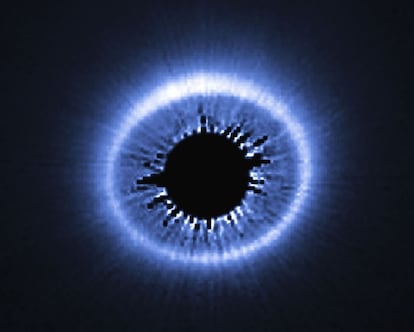Frozen water found in a young star system for the first time

Earth owes its water to one of the worst known cataclysms. About 4 billion years ago, Jupiter, Saturn, Uranus, and Neptune changed orbits and pushed a terrible shower of asteroids, comets, and other bodies into the inner solar system, where they impacted the Moon , Earth, and the other rocky planets. These astronomical bombs, the scars of which can still be seen on our satellite, were loaded with ice. Many astronomers believe that much of our planet's water has this extraterrestrial origin, and that it arrived at the crucial moment for life to emerge for the first time.
Now, a team of astronomers has discovered crystalline water ice for the first time in a young star system beyond our sun. The water ice is located within the so-called debris disk—a huge ring of dust and rocks—that orbits HD 181327, a star 155 light-years away that is similar to our sun. The discovery is important evidence that what happened in our solar system can happen everywhere else in the universe.
"In this star, we are seeing our own past," summarizes Asturian astronomer Noemí Pinilla-Alonso , co-author of the study. The work was made possible thanks to the James Webb Space Telescope . NASA's telescope, which has captured the light emitted by the debris disk and identified the molecules present. The work is published this Wednesday in Nature , a leading source of global science.
Until now, the presence of water ice had only been confirmed on some moons of giant planets, and also on dwarf planets and other bodies that form the Kuiper Belt , located beyond the orbit of Neptune. In 2012, the Hubble Space Telescope already suspected the presence of ice on HD 181327, but was unable to confirm it. The extraordinary capacity of the infrared instruments on the James Webb telescope, launched in 2021, has made it possible to confirm the presence of this essential compound beyond any doubt.

Astronomers believe the debris ring they observe around this star may be very similar to the one that existed around the Sun before the giant planets swept through its orbit. The star is only 23 million years old—a mere breath compared to our Sun's 4.6 billion years—and its disk is about three times larger than the Kuiper Belt, spanning some 18 billion kilometers.
“Ice on Earth is crystalline; it forms under the right conditions to take on a hexagonal shape,” explains Pinilla-Alonso. “Amorphous ice, on the other hand, forms rapidly and therefore doesn't have time to organize itself. This is the most common type of ice in the universe. Curiously, in the Kuiper Belt, the Webb study has shown us that all objects with water contain crystalline water, of the same type now detected in HD 181327, something we didn't know before and are trying to explain,” he explains.
Webb has made it possible to observe the so-called snow line: the boundary beyond which all elements are in the form of ice. In the areas closest to the star, the presence of water ice is almost nonexistent due to the heat, while in the more distant areas it accounts for up to 20% of the total composition.
Astronomers believe that the bodies orbiting within the ring are colliding with each other, generating larger bodies that could one day become planets. These impacts also scatter millimeter-sized ice particles throughout the system. The presence of carbon monoxide and possibly carbon dioxide, along with essential minerals, has also been confirmed in this star, Pinilla-Alonso explains; this further resembles this system to our own.
“We're probably seeing things very similar to what happened at the origin of our own solar system,” explains Pinilla-Alonso. “Solar systems begin with the protoplanetary disk of dust and gas, then with debris disks like this one, and finally with the formation of planets. Webb has detected the presence of ice at all of these stages. Observing this disk, and likely others to come, allows us to understand the bridges between these different phases for the first time,” adds the astronomer, who recently joined the University of Oviedo as part of the Atrae program and who co-authored the study with colleagues from the Universities of Florida and Arizona, and the Space Telescope Institute, the James Webb mission center.

Guillem Anglada , a researcher at the Institute of Astrophysics of Andalusia (IAA-CSIC), who was not involved in the study, highlights its value. “It's a very important discovery, although not entirely unexpected,” he argues. The astronomer focuses on the study of protoplanetary disks, and his team has confirmed the presence of ice in these rings using space-based and ground-based telescopes. When a star reaches its first million years, its radiation evaporates almost all of the gas, leaving only dust, from which the debris disk forms. “This work shows quite clearly that there is a reservoir of ice in the outermost layers that is later spread thanks to the collision” of bodies of dust and rock, which are “continuously” impacting, Anglada reasons.
The snow line marks a crucial boundary here. Ice-laden bodies pushed by giant planets can cross the boundary and eventually collide with rocky planets, forming oceans of liquid water. “This is what happened in our solar system, but it's just a theory. We're still far from knowing how it happens, and each case may be different,” Anglada warns.
A catastrophic event like that caused by the gas giants has not yet occurred on the observed star, but it is likely that it could. Preliminary studies suggest the presence of planets in this belt. And even if none existed, the authors of this new study estimate that they could form in about 100 million more years. Meanwhile, closer to home, data continues to accumulate on the possible presence of a ninth planet in the solar system that could be disrupting the movement of icy bodies in the most remote areas of the Kuiper Belt.
EL PAÍS





